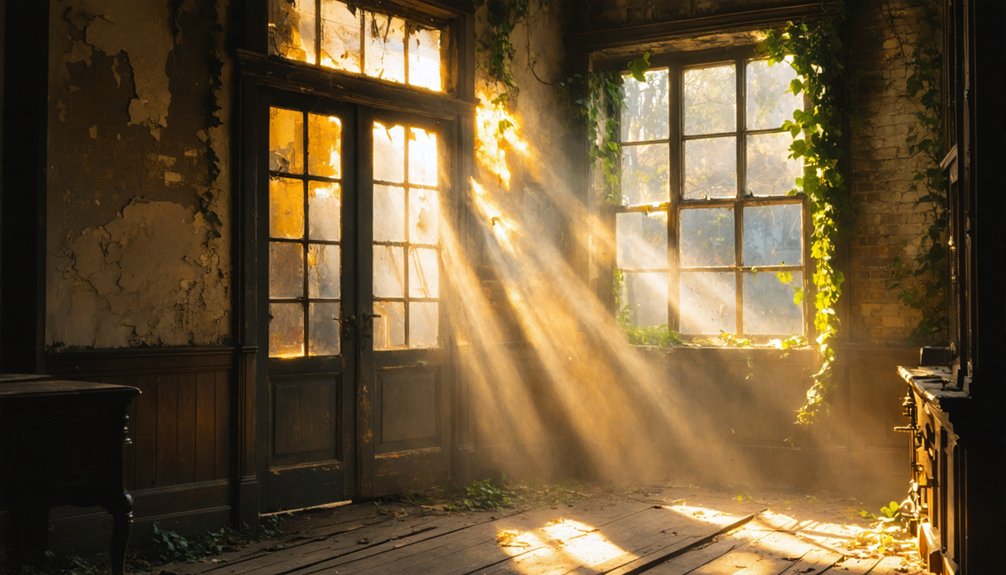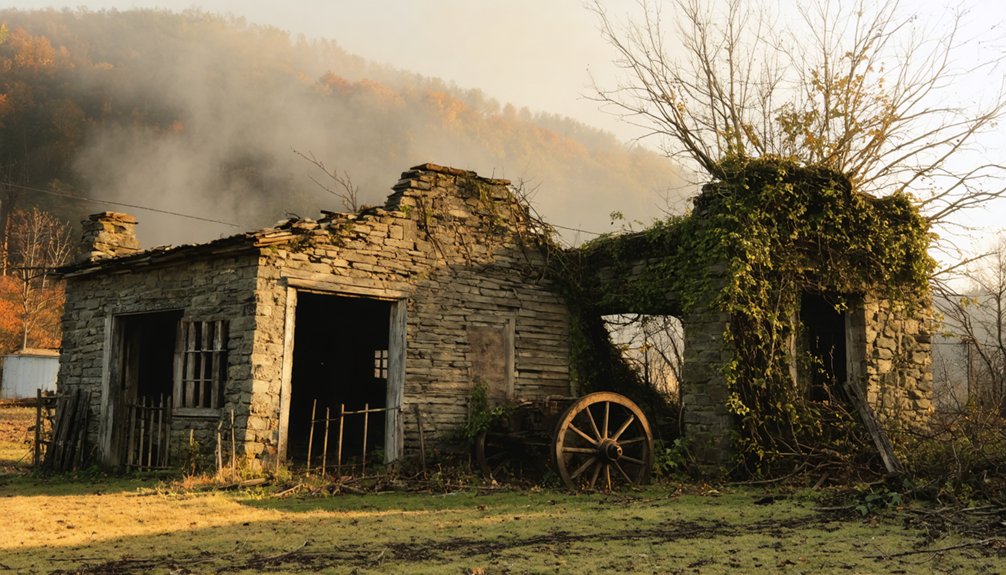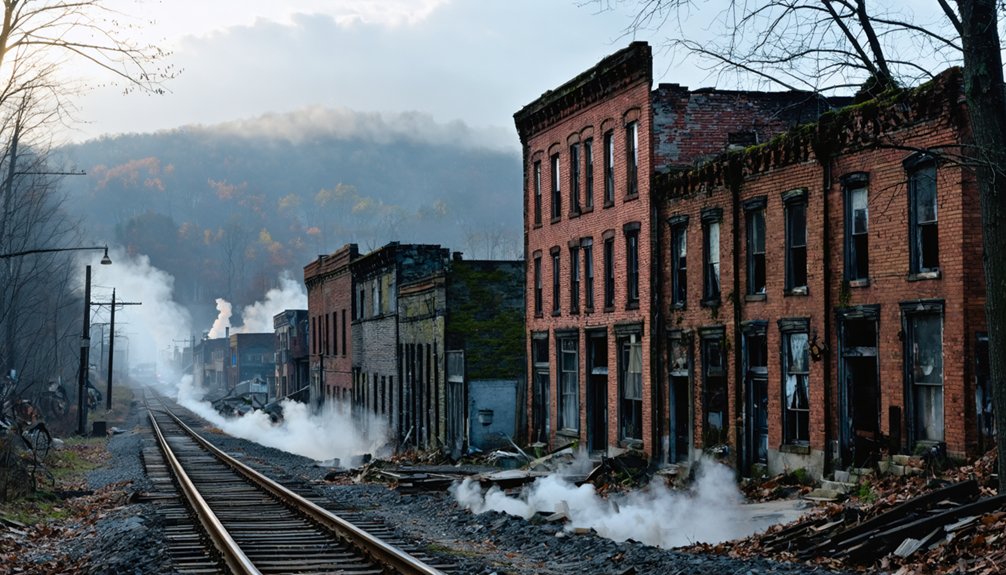When exploring Civil War ghost towns, you’ll need sturdy boots, work gloves, and N95 respirators for safety. Always verify ownership status before visiting to avoid trespassing violations. Fort Jefferson and Bodie offer remarkable preserved sites with authentic structures. Assess structural integrity carefully, as deteriorated wooden frameworks can collapse without warning. Document respectfully by photographing rather than handling artifacts. The stories captured within these weathered walls await those who approach with proper preparation and historical reverence.
Key Takeaways
- Always carry essential safety gear including sturdy boots, respirators, work gloves, and reliable lighting when exploring abandoned structures.
- Verify legal ownership status beforehand and obtain necessary permissions to avoid trespassing violations and potential penalties.
- Assess structural integrity of buildings before entering, watching for deteriorated wooden frameworks, weak walls, and unstable floorboards.
- Be aware of environmental hazards like abandoned mine shafts, sinkholes, underground fires, and contaminated materials.
- Document sites respectfully by staying on marked paths, photographing rather than handling artifacts, and researching historical significance beforehand.
The Historical Context of Civil War Ghost Towns

Devastation, like a merciless tide, swept through countless communities during civil conflicts of the 19th and 20th centuries, creating the abandoned settlements we now call Civil War ghost towns.
You’re witnessing the remnants of once-thriving towns like Andersonville, Cassville, and Belchite—places where families built lives before warfare obliterated their futures.
The Civil War’s destructive path left Chambersburg in ashes after Confederate forces burned over 500 buildings when ransom demands weren’t met.
When ransoms went unpaid, Chambersburg became ash and rubble under Confederate torches—over 500 buildings reduced to memory.
In Spain, Belchite’s siege pitted 20,000 Republican soldiers against 3,000 Falangists, resulting in total abandonment.
The Community Impact extended beyond physical destruction—economic collapse prevented rebuilding, while military occupation permanently displaced civilians. Franco’s government deliberately chose not to reconstruct Belchite, instead preserving it as evidence of destruction. Towns like Rodney, Mississippi suffered when the Mississippi River shifted, leaving them stranded miles from vital trade routes.
These ghost towns stand as solemn monuments to freedom’s cost, their empty structures evidence to war’s enduring wounds.
Most Preserved Civil War Ghost Towns Worth Visiting
When you venture to these remarkably intact sites, Fort Jefferson’s imposing naval fortifications stand as silent sentinels to military engineering during the Civil War era.
Bodie’s exceptionally preserved mining structures offer you a rare glimpse into the gold rush communities that continued to thrive in the aftermath of national conflict. Maintained in a state of arrested decay, the town presents buildings with original furniture as if residents had simply vanished. In its heyday, Bodie reached a bustling population of around 10,000 people before beginning its decline in the early 20th century.
These destinations present extraordinary opportunities to witness American history frozen in time, with artifacts and architecture that scholars consider among the most historically significant Civil War-adjacent sites remaining in their original locations.
Situated among the azure waters of the Florida Keys, Fort Jefferson stands as perhaps the most remarkably preserved Civil War-era naval fortification accessible to modern visitors.
This colossal brick structure—comprising over 16 million bricks—played a vital role in naval operations during the conflict, serving as a strategic Union blockade point against Confederate shipping.
When you visit, you’ll walk where Union warships once anchored in harbor, protecting a garrison that swelled to over 1,000 occupants by 1865.
Despite never firing a shot in combat, the fort’s historical significance stems from its unwavering Union control throughout the war and its infamous role housing Lincoln assassination conspirators.
Though technological advances eventually rendered it obsolete, Roosevelt’s 1935 preservation designation guarantees you can experience this maritime sentinel firsthand. Located within Dry Tortugas National Park, the fort now sits in a protected area that is 98% underwater. The Kentucky site also became an important Union post during the Civil War due to its strategic location along the Mississippi River.
Bodie’s Mining Preservation
While Fort Jefferson preserves America’s naval Civil War legacy, the ghost town of Bodie stands as the nation’s most pristinely maintained inland relic from the nineteenth century.
This California National Historic Landmark embodies “arrested decay” preservation—buildings remain exactly as abandoned, with original furnishings intact. The architectural integrity of wooden structures along Main Street offers an authentic window into boomtown prosperity following the 1875 gold strike that yielded up to $70 million. The town produced more than $38 million in gold and silver during its peak years from 1877 to 1882.
When you visit Bodie’s preserved historical architecture, you’ll appreciate:
- Window-peeping into over 110 original structures containing period artifacts
- The Methodist church, jail, and Miners Union Hall showcasing frontier construction techniques
- Special access through guided tours of the Miller House and Standard Stamp Mill
Preservation efforts balance decay prevention with maintaining the site’s authentic abandoned aesthetic, ensuring this freedom-era mining town endures. Visitors can experience the town’s historical vibrancy that once included 70 saloons and numerous entertainment venues during its peak years.
Essential Safety Equipment and Preparations
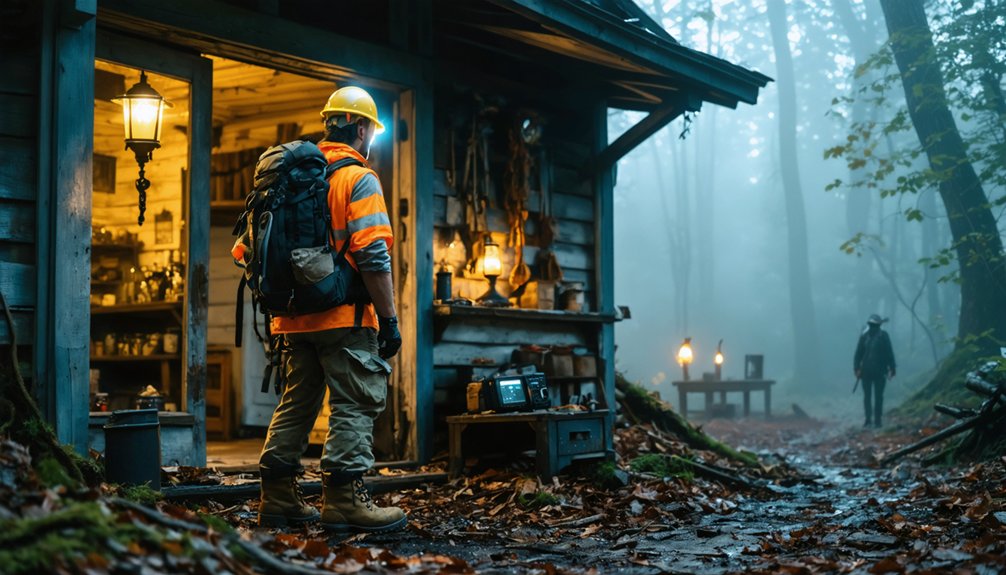
As you commence upon the profound historical journey of exploring Civil War ghost towns, proper safety equipment and meticulous preparation become not merely recommendations but essential prerequisites for preservation of both your wellbeing and these sacred historical sites.
Your safety gear should include sturdy ankle-supporting boots, layered clothing, work gloves, and an N95 respirator to protect against the invisible threats lurking within these time-capsules of American conflict.
Don’t venture forth without reliable illumination—headlamps with backup batteries could mean the difference between safe passage and perilous circumstance. A backup flashlight is recommended to provide additional lighting when navigating through particularly dark or hazardous areas of abandoned structures. Monitor your fuel consumption regularly, especially when traveling in off-road vehicles to remote ghost towns, as gas stations are sparse in rural areas.
For emergency preparedness, always carry a thorough first aid kit, three days of survival supplies, and maintain communication protocols with trusted contacts.
Share your expedition plans and establish regular check-ins. In remote locations, satellite communication devices transcend the limitations of cellular networks, ensuring you’re never truly disconnected from potential assistance.
Understanding Legal Access and Permissions
Maneuvering the complex legal terrain of Civil War ghost towns requires exceptional diligence before your boots ever touch these hallowed grounds.
These historically significant sites often exist in a jurisdictional confluence of private ownership, historical designation, and archaeological protection laws that demand your respect and compliance.
- Verify ownership status – Many ghost towns remain private property despite their abandoned appearance, making you subject to trespassing laws unless you’ve secured explicit permission from the current deed holder.
- Research historical designations – Sites on the National Register may have specific permission requirements or designated visiting hours that legitimate your presence.
- Review archaeological protections – Federal and state statutes like ARPA prohibit artifact collection or site disturbance, with violations carrying substantial penalties even when access is authorized.
Structural Dangers and Physical Hazards to Avoid
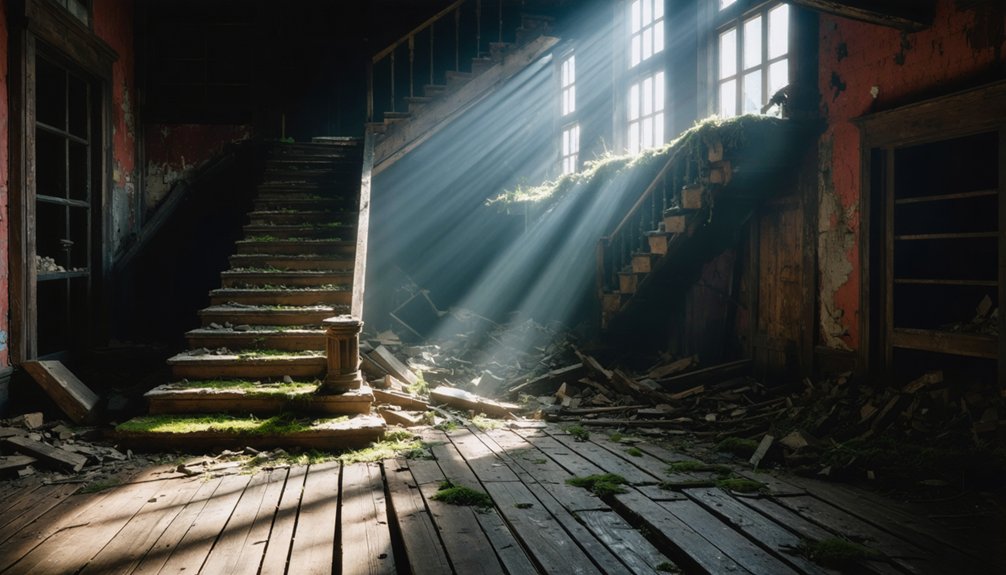
Beneath their haunting allure and historical significance, abandoned Civil War ghost towns harbor perilous structural dangers that demand vigilant awareness from every visitor.
Buildings constructed during this era lack modern reinforcement standards, with wooden frameworks deteriorated through decades of exposure. Floorboards may give way beneath your weight, while walls risk sudden collapse.
The ground itself presents invisible threats—underground fires create unstable terrain, while abandoned mine shafts have left the earth honeycombed with voids. Sinkholes may form without warning.
Environmental contamination compounds these risks, with toxic levels of lead and zinc lingering in soil and dust.
Always prioritize structural integrity assessment before entering any remnant building.
Watch for telltale signs of collapse risks: sagging rooflines, cracked foundations, or canted walls. Your safety depends on respecting these silent warnings.
Documenting Your Ghost Town Exploration
While traversing physical dangers represents the foremost priority during ghost town exploration, capturing these fleeting historical remnants stands as a profound responsibility for visitors who witness these disappearing fragments of Civil War history. Your documentation preserves invaluable historical narratives through thoughtful photography techniques and careful preparation.
Preserving America’s vanishing heritage through your lens—a historical responsibility as vital as the journey itself.
- Equipment Checklist: Assemble a versatile arsenal including wide-angle lenses for expansive landscapes, prime lenses for artifact details, and a sturdy tripod for low-light documentation.
- Optimal Timing: Arrive near dawn (5 a.m.) to capture golden hour illumination that reveals architectural nuances and creates dramatic shadow play across weathered structures.
- Subject Hierarchy: Document systematically—begin with establishing shots of town layouts, then photograph key buildings, and finally capture intimate details like rusted implements and cemetery markers that tell personal histories.
Seasonal Considerations for Safe Visits
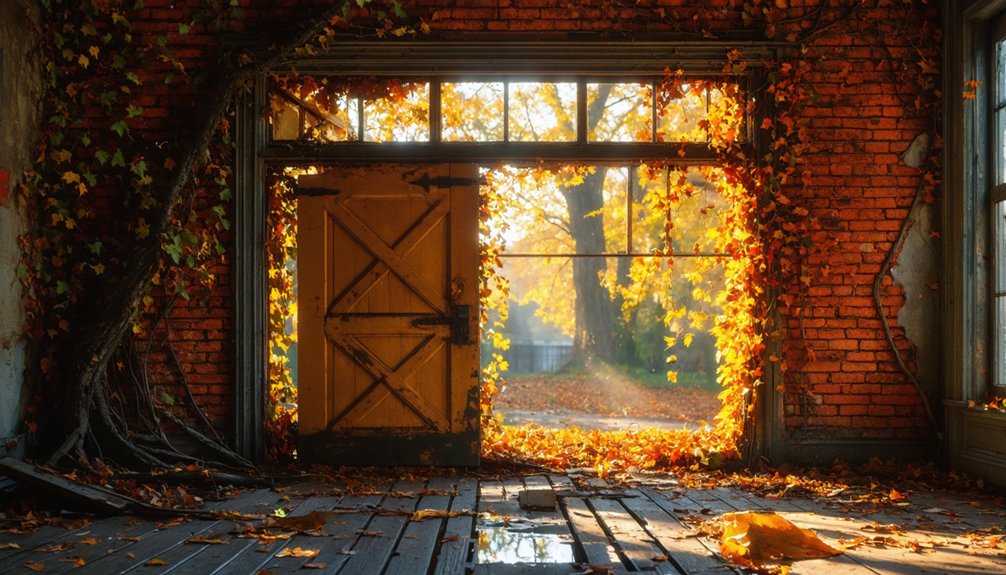
The Civil War ghost towns that dot our American landscape transform dramatically through nature’s seasonal cycles, presenting unique challenges and opportunities for exploration throughout the year.
Late spring to early autumn typically offers the safest window for your expeditions, when trails remain navigable and weather extremes abate.
Your seasonal attire must adapt accordingly—layered, waterproof gear for winter and spring’s wet conditions; breathable fabrics and sun protection during summer’s punishing heat that once reached 109°F during battles.
Diligent weather monitoring before and during your journey can prevent dangerous encounters with flash floods or sudden temperature drops.
Remember that spring vegetation may conceal hazardous ruins, while autumn’s fallen leaves often mask unstable ground.
Always carry navigation tools and emergency supplies tailored to each season’s particular threats.
Respecting Historical Significance While Exploring
Beyond seasonal preparations lies a profound responsibility to honor the historical sanctity of these weathered remnants. When exploring Civil War ghost towns, practice historical empathy by envisioning the lives once lived within these hallowed grounds.
These sites aren’t merely abandoned structures but repositories of our collective heritage demanding cultural sensitivity.
To respectfully engage with these historical treasures:
Approach these hallowed grounds with reverence, for they hold our shared past within their weathered frames.
- Observe without disturbing – photograph rather than touch, leaving artifacts undisturbed for future generations
- Adhere strictly to marked pathways and boundaries established by preservation authorities
- Research the site’s significance beforehand to appreciate the complex narratives embedded in crumbling walls and silent streets
Remember that your footsteps follow those of soldiers, settlers, and citizens who shaped our nation’s trajectory. Their stories deserve reverence through your conscientious exploration.
Frequently Asked Questions
Can Children Safely Participate in Ghost Town Explorations?
Children may participate when you guarantee proper supervision, follow strict exploration guidelines, obtain legal permissions, and bring appropriate safety equipment—honoring both child safety and the historical reverence these hallowed locations demand.
Are There Guided Tours Specifically Focused on Civil War Ghost Towns?
Yes, you’ll find specialized guided history tours at Harpers Ferry, Gettysburg, Blakeley State Park, and Sharpsburg, where knowledgeable guides—sometimes incorporating historical reenactments—illuminate Civil War ghost towns’ poignant, forgotten stories.
How Do Smartphones Affect Paranormal Experiences in Ghost Towns?
Reading between the lines, your smartphone technology fundamentally alters paranormal investigations in ghost towns by capturing data through sensors, potentially enhancing experiences while simultaneously introducing electromagnetic interference that seasoned researchers meticulously document and analyze.
What Indigenous Histories Intersect With Civil War Ghost Town Sites?
You’ll discover indigenous perspectives were systematically erased from historical narratives at sites like Rodney, Cahawba, Harshaw, and La Paz, where Native peoples’ displacement preceded the Civil War’s transformative impact on these landscapes.
Which Ghost Towns Offer Overnight Accommodation Experiences Nearby?
You’d think ghost towns offer no shelter, yet Gettysburg provides profound historical lodgings where you’ll find haunted inns like Tillie Pierce House and the venerable Gettysburg Hotel—sacred spaces where freedom intertwines with spectral legacy.
References
- https://en.wikivoyage.org/wiki/Ghost_towns
- https://www.frrandp.com/p/ghost-towns-map.html
- https://www.geotab.com/ghost-towns/
- https://devblog.batchgeo.com/ghost-towns/
- https://deepsouthurbex.com/2020/01/02/6-south-alabama-ghost-towns/
- https://www.losethemap.com/scariest-ghost-towns-in-the-world/
- https://nvtami.com/nevada-ghost-towns-map/
- https://dotsonmaps.com/dots/tag/abandoned+towns+interactive+map
- https://www.arcgis.com/apps/mapviewer/index.html?webmap=de9e7139dcc94593810fc76125667239
- https://www.youtube.com/watch?v=v8WGpuFEuqU
